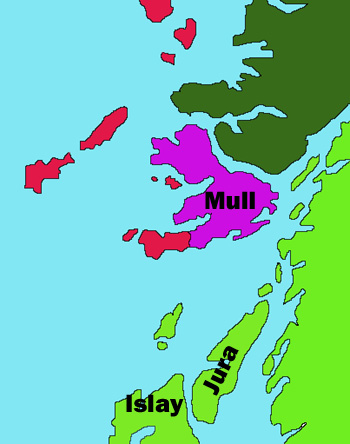

Home | Arran | Whisky | Links & references
Mull is also an extremely popular destination for geologists, especially those interested in studying the Tertiary lavas which make up most of the area.
These lavas overlie a base of Lewisian Gneiss, which is one of the oldest rock units to be found in the British Isles. The gneiss units are high-grade metamorphic rocks estimated to be around 2700 million years old. They can be recognized by the dark bands of amphibolitic material amongst the bands of lighter quartz and feldspathic material.
Around 60 million years ago, during the Paleocene, Greenland and Europe were only just starting to separate to form the northeast Atlantic Ocean. This resulted in major volcanism along the west coast of Scotland. The volcanoes found in the Mull region would have been comparable to those found on Hawaii today.
After about 1 million years of active volcanism, the area had been transformed into a landscape dominated by a thick, extensive basaltic plateau.
Between some of these lava flows, lateritic red bole can be found. This unit is a tropical red soil. Together with the fossil record from this time, it has been established that Mull was located at a warm, tropical latitude.
As this land mass gradually drifted northwards, it experienced colder climates and new weathering processes.
Within the last 2.4 million years, there have been many periods of global cooling, or ice ages, and the region of Mull has been significantly affected.
After many ice ages resulting in extensive glaciation, the volcanoes were gradually stripped away to their cores. The granitic cores can still be found in the southeast of Mull and on Ardnamurchan, just north of Mull.


©2004, Andrew Rogie